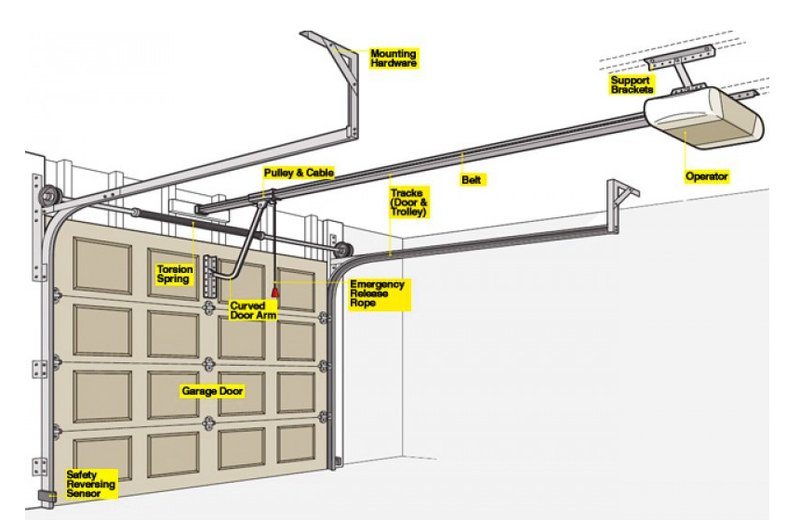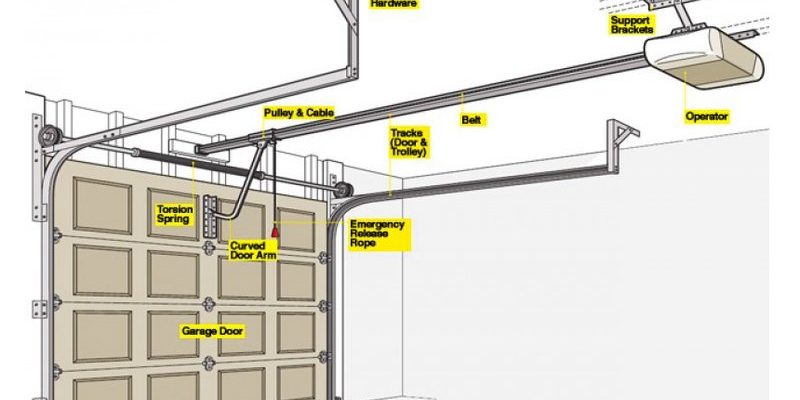
Picture your garage remote as the “magic wand” of suburban life. Tap a button, and—presto!—your heavy garage door lifts, rain or shine. But this magic has limits, and understanding those limits can save you frustration. Let’s break down *how far* an Overhead Door garage remote will work, why it sometimes stalls out, and what you can do to squeeze out a few more feet if you need it.
Typical Overhead Door Garage Remote Range
Let me explain how the range works—the distance from which your Overhead Door remote can successfully signal the opener. Most standard remotes from this brand are designed to work anywhere from about **100 to 150 feet** in open, ideal conditions. That’s roughly the length of a basketball court, or the distance from your mailbox back to your garage. But let’s be honest: most of us don’t live on perfectly empty lots.
That *real world* range often drops depending on what’s in between you and your garage. Trees, parked cars, or even a neighbor’s brick mailbox can gobble up signal strength. Thick walls, especially if they’re coated with metal or wire mesh, will slash that 100-foot promise down to 60 feet or less. That’s why sometimes your button-press works from the end of the driveway, but other mornings you need to stand right in front of the door.
Manufacturers usually advertise the *maximum* possible range under “laboratory” conditions: open field, no obstacles, brand-new batteries. But nobody lives in a laboratory. If your Overhead Door remote seems spotty, you’re not “doing it wrong”—you’re just bumping into real-life physics.
Factors That Control Garage Remote Range
So, what’s really behind the scenes here? Signal range isn’t just a magic number—it’s a mix of a few key things. First, we’re working with **radio frequency (RF) signals**. Just like WiFi or walkie-talkies, garage remotes send invisible codes through the air. If you think of the remote’s signal like shouting across a field, any trees, cars, or walls between you and the door will muffle your “voice.”
Here’s the thing:
- Battery life: Old or low-quality batteries seriously cut down the distance. The weaker the battery, the shorter the range—sometimes *way* shorter.
- Interference: Got lots of electronics around the garage? Motion sensors, LED lights, or even neighbor’s remotes can scramble the signal.
- Obstacles & materials: Metal doors, thick concrete, or even that big SUV parked out front can block or bounce signals.
- Remote and opener age: Older remotes (or openers) might not play nice with newer RF codes or standards, limiting range or reliability.
Honestly, you might even notice the remote works better in winter than summer—or vice versa—thanks to humidity or wet surfaces reflecting signals. It’s a circus of variables and, sometimes, just a bit of luck.
How Remote Codes and Pairing Affect Range
You might be wondering: does the way you *pair* or *sync* your remote with the opener have anything to do with range? Short answer: *kind of*. Overhead Door garage remotes use rolling code technology, which means every press sends a unique security code to the opener. This helps keep your home safe, since “hacking” static codes has gotten easier over the years.
The good news is, pairing mistakes usually don’t cut down your range—they just mean the door won’t open *at all*. However, if you’ve got multiple remotes or recently tried to reset or program a new one, incorrect pairing can sometimes cause the opener to drop signals or behave unpredictably.
It’s smart to double-check your remote’s programming if you start noticing your range is shrinking *and* the door sometimes ignores you completely. Sometimes, performing a full reset and re-sync will iron out all the weirdness. Follow your Overhead Door’s manual for step-by-step instructions, or check online videos for your specific model if the paper guide is long gone.
Troubleshooting Poor Range or Signal Issues
If your range feels more like 10 feet than 100, don’t worry—you’ve got options before tossing the remote. Start with the simple stuff. Pop open the back of your remote and swap in a fresh battery. It’s embarrassingly common how often dead or weak batteries are the main culprit.
Still weak? Try standing in different spots around your driveway. If the signal jumps back up in one spot but not another, you’ve probably got interference. Electronics inside the garage (like wireless doorbells or security sensors) can jam things up. Yes, even those fancy new LED garage lights can cause trouble—if this matches your setup, try swapping bulbs for a different type.
You can also try re-pairing the remote. Most Overhead Door remotes have a “learn” button on the opener unit. Hold it down until it blinks, then press the remote button. This clears out old remotes and pairs the new signal, which sometimes fixes odd behavior or short range.
If none of these steps fix the problem, you might be looking at a failing remote or even a receiver issue inside your garage opener.
Universal vs. Overhead Door Brand Remotes: Range Differences
You might have seen universal remotes online and wondered if they’d work any better. Here’s the truth: universal garage remotes can be convenient, especially if you want fewer devices on your keychain. But, their range varies just as wildly as brand-name remotes, sometimes even less. Some models just aren’t calibrated as precisely for Overhead Door openers.
When you pair (or “code”) a universal remote with your system, it’ll usually connect fine. But because it’s designed to work with lots of brands, not just Overhead Door, the antenna inside is more generic. This means you *might* notice a range drop of 10-20 feet compared to your original remote.
If range is your top priority, sticking with an official Overhead Door remote is usually the safer bet. Still, if you prefer having just one remote for multiple doors (or brands), universal models can make life less cluttered. Just don’t expect them to magically boost your signal.
Impact of Obstructions and Home Layout on Remote Range
Let’s talk about your physical environment. The biggest range killer for any garage remote—Overhead Door included—is what stands between you and the opener. Steel-reinforced walls, thick garage doors, or even aluminum siding can block or scatter signals like a brick wall blocks a WiFi router. If your house has a lot of these, expect the remote’s range to shrink.
If your garage is attached to your home and you try to open the door from inside the house, you might notice the signal barely makes it through. Here’s a trick: try opening a nearby window or moving closer to the garage’s outer wall before pressing the button. Sometimes, relocating just a few feet clears a path for the RF signal to reach its target.
Obstacles on the driveway matter, too. If your car’s roof racks, bicycles, or even trash bins sit between you and the garage, that signal might fizzle out. Testing in different spots is the best way to find “sweet spots” for your remote.
How to Extend the Range of Your Overhead Door Garage Remote
Honestly, who wouldn’t want a few extra feet of reliable range? If you’re tired of playing “red light, green light” with your garage door, there are ways to boost performance a bit.
- Upgrade to stronger batteries: Don’t cheap out here. Fresh, high-quality batteries give the transmitter full power every time you press the button.
- Adjust the opener antenna: There’s usually a thin wire hanging from your garage opener’s motor. Make sure it’s fully extended, not tucked or bent. Sometimes a slight adjustment angles the antenna for better reception.
- Reduce interference: If possible, unplug or reposition electronics near the opener that emit signals or might jam frequencies.
- Replace your remote: If it’s older, buying a new Overhead Door remote can bump up the range—newer models often have more efficient transmitters.
Some folks even try aftermarket RF “signal repeaters,” but results can be hit or miss. Stick with the basics before investing in gadgets.
When to Consider Professional Help or Replacement
Sometimes, you hit a wall (figuratively and literally). If you’ve replaced batteries, tried re-pairing, adjusted antennas, and the range is still lousy, it might be time for professional help. Internal receiver components in the opener itself can fail after years of daily use. A garage door technician can test the circuitry, try a new receiver board, or spot wiring issues you’d never find with a basic checkup.
If your opener is very old, it may only support older RF frequencies or outdated rolling code technology. In these cases, upgrading the opener (and remote) to a new model might be the only way to get modern range and reliability. It’s not just about distance—newer systems also improve security.
If you rely on your garage for everyday access and the remote range is driving you crazy, don’t be afraid to call in an expert. Sometimes, a quick professional tune-up makes all the difference.
Key Takeaways: Getting the Most from Your Overhead Door Garage Remote
So, how far is the range of an Overhead Door garage remote? In perfect conditions, expect up to 100–150 feet. But real life—filled with walls, cars, weather, and gadgets—often brings that number down. If your remote isn’t keeping up, a battery swap, antenna tweak, or careful troubleshooting can often fix it. Stick with official remotes for best results, and don’t forget that professional help is out there when you’re stuck.
Owning a garage remote isn’t magic, but understanding how it works puts you back in control—no more guessing games at the end of the driveway. Here’s to smooth arrivals, dry walks from the car, and doors that listen the first time you ask.
